diff options
| author | Joel Hans <joel@netdata.cloud> | 2020-12-15 07:31:31 -0700 |
|---|---|---|
| committer | GitHub <noreply@github.com> | 2020-12-15 07:31:31 -0700 |
| commit | 50e8edabaa2f02c3345ce3eff9d45a85c51d5fb2 (patch) | |
| tree | 90acc6ff655cf6777824a1e67e74006550a5a227 /web | |
| parent | 2f90dabed67801d61b33fae12494ac055a78d398 (diff) | |
Add documentation for time & date picker in Agent and Cloud (#10347)
* Add new documentation for time & date pickers
* Update GIFs
* GIF in main README
* Fixes for Amy and Odysseas
Diffstat (limited to 'web')
| -rw-r--r-- | web/README.md | 16 | ||||
| -rw-r--r-- | web/gui/README.md | 85 |
2 files changed, 56 insertions, 45 deletions
diff --git a/web/README.md b/web/README.md index 1970e97204..fc1d37170d 100644 --- a/web/README.md +++ b/web/README.md @@ -1,6 +1,6 @@ <!-- title: "Dashboards" -description: "Netdata comes bundled with hundreds of real-time, context-aware charts that help your monitor health and performance without configuration." +description: "Every Netdata Agent comes bundled with hundreds of interactive, customizable charts designed by monitoring and troubleshooting experts." custom_edit_url: https://github.com/netdata/netdata/edit/master/web/README.md --> @@ -14,11 +14,10 @@ team and the community, but you can also customize them yourself. There are two primary ways to view Netdata's dashboards: -1. The [standard web dashboard](/web/gui/README.md) that comes pre-configured with every - Netdata installation. You can see it at `http://SERVER-IP:19999`, or - `http://localhost:19999` on `localhost`. You can customize the contents and - colors of the standard dashboard [using - JavaScript](/web/gui/README.md#customizing-the-standard-dashboard). +1. The [local Agent dashboard](/web/gui/README.md) that comes pre-configured with every Netdata installation. You can + see it at `http://NODE:19999`, replacing `NODE` with `localhost`, the hostname of your node, or its IP address. You + can customize the contents and colors of the standard dashboard [using + JavaScript](/web/gui/README.md#customizing-the-standard-dashboard). 2. The [`dashboard.js` JavaScript library](#dashboardjs), which helps you [customize the standard dashboards](/web/gui/README.md#customizing-the-standard-dashboard) @@ -27,9 +26,8 @@ There are two primary ways to view Netdata's dashboards: You can also view all the data Netdata collects through the [REST API v1](/web/api/). -No matter where you use Netdata's charts, you'll want to know how to -[use](#using-charts) them. You'll also want to understand how Netdata defines -[charts](#charts), [dimensions](#dimensions), [families](#families), and +No matter where you use Netdata's charts, you'll want to know how to [use](#using-charts) them. You'll also want to +understand how Netdata defines [charts](#charts), [dimensions](#dimensions), [families](#families), and [contexts](#contexts). ## Using charts diff --git a/web/gui/README.md b/web/gui/README.md index 8e541164bd..c13f3d6cbc 100644 --- a/web/gui/README.md +++ b/web/gui/README.md @@ -1,47 +1,40 @@ <!-- ---- -title: "The standard web dashboard" -date: 2020-05-04 +title: "Local Agent dashboard" +description: "The local Netdata Agent dashboard is the heart of health monitoring and performance troubleshooting, with hundreds of real-time charts." custom_edit_url: https://github.com/netdata/netdata/edit/master/web/gui/README.md ---- --> -# The standard web dashboard +# Local Agent dashboard -The standard web dashboard is the heart of Netdata's performance troubleshooting toolkit. You've probably seen it +The local Netdata Agent dashboard is the heart of Netdata's performance troubleshooting toolkit. You've probably seen it before: 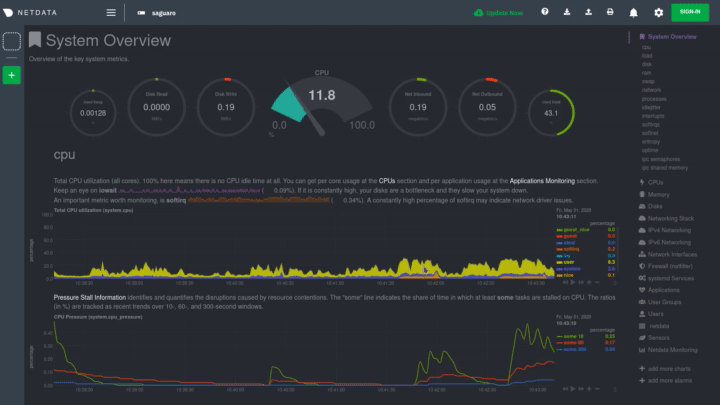 +action](https://user-images.githubusercontent.com/1153921/101513938-fae28380-3939-11eb-9434-8ad86a39be62.gif) -Learn more about how dashboards work and how they're populated using the -`dashboards.js` file in our [web dashboards overview](/web/README.md). +Learn more about how dashboards work and how they're populated using the `dashboards.js` file in our [web dashboards +overview](/web/README.md). By default, Netdata starts a web server for its dashboard at port `19999`. Open up your web browser of choice and navigate to `http://NODE:19999`, replacing `NODE` with the IP address or hostname of your Agent. If you're unsure, try `http://localhost:19999` first. -> In v1.21 of the Agent, we replaced the legacy dashboard with a refactored dashboard written in React. By using React, -> we simplify our code and give our engineers better tools to add new features and fix bugs. The only UI change with -> this dashboard is the top navigation and left-hand navigation for [Cloud integration](/docs/agent-cloud.md). The old -> dashboard is still accessible at the `http://NODE:19999/old` subfolder. +Netdata uses an [internal, static-threaded web server](/web/server/README.md) to host the HTML, CSS, and JavaScript +files that make up the local Agent dashboard. You don't have to configure anything to access it, although you can adjust +[your settings](/web/server/README.md#other-netdataconf-web-section-options) in the `netdata.conf` file, or run Netdata +behind an [Nginx proxy](https://learn.netdata.cloud/docs/agent/running-behind-nginx), and so on. -Netdata uses an [internal, static-threaded web server](/web/server/README.md) to host the -HTML, CSS, and JavaScript files that make up the standard dashboard. You don't -have to configure anything to access it, although you can adjust [your -settings](/web/server/README.md#other-netdataconf-web-section-options) in the -`netdata.conf` file, or run Netdata behind an Nginx proxy, and so on. +## Navigating the local dashboard -## Navigating the standard dashboard - -Beyond charts, the standard dashboard can be broken down into three key areas: +Beyond charts, the local dashboard can be broken down into three key areas: 1. [**Sections**](#sections) -2. [**Metrics menus/submenus**](#metrics-menus) -3. [**Cloud menus: Spaces, War Rooms, and Visited nodes)**](#cloud-menus-spaces-war-rooms-and-visited-nodes) +2. [**Time & date picker](#time--date-picker) +3. [**Metrics menus/submenus**](#metrics-menus) +4. [**Netdata Cloud menus: Spaces, War Rooms, and Visited nodes)**](#cloud-menus-spaces-war-rooms-and-visited-nodes) - +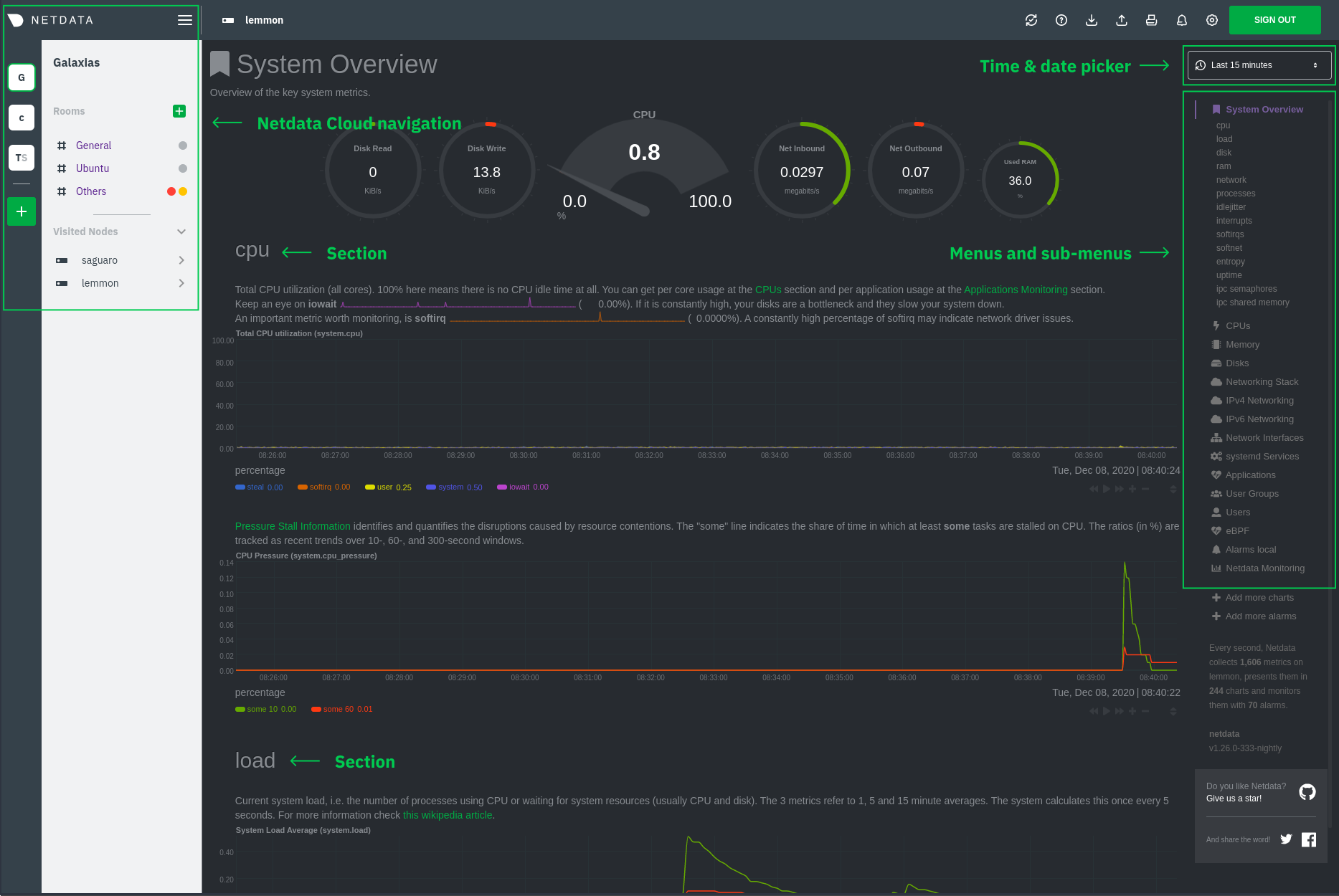 ### Sections @@ -53,16 +46,36 @@ broken down into [contexts](/web/README.md#contexts) and An example of the **Memory** section on a Linux desktop system.  +dashboard](https://user-images.githubusercontent.com/1153921/101508423-e354cc00-3934-11eb-9b33-3ad57a5988b4.png) + +All sections and their associated charts appear on a single page, so all you need to do to view different sections is +scroll up and down. But it's usually quicker to use the [menus](#metrics-menus). + +### Time & date picker + +The local dashboard features a time & date picker to help you visualize specific timeframes of historical metrics. The +picker chooses an appropriate default to always show per-second granularity based on the width of your browser's +viewport. + +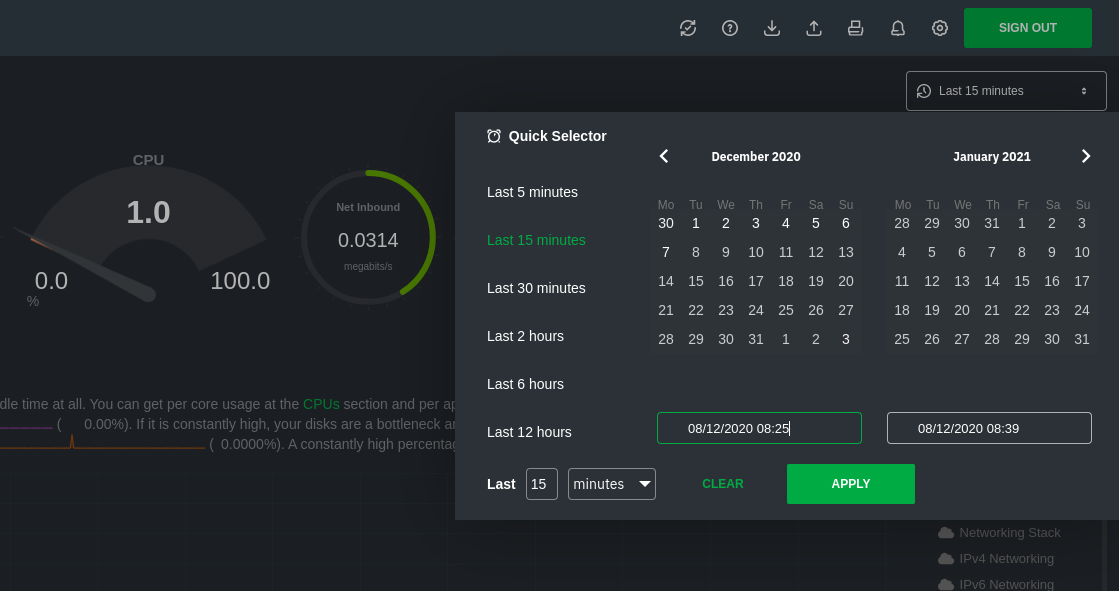 + +Use the Quick Selector to show metrics from the last 5 minutes, 15 minutes, 30 minutes, 2 hours, 6 hours, or 12 hours. + +Beneath the Quick Selector is an input field and dropdown you use in combination to select a specific timeframe of +minutes, hours, days, or months. Enter a number and choose the appropriate unit of time. + +Use the calendar to select multiple days. Click on a date to begin the timeframe selection, then an ending date. + +Click **Apply** to re-render all visualizations with new metrics data, or **Clear** to restore the default timeframe. -All sections and their associated charts appear on a single "page," so all you -need to do to view different sections is scroll up and down the page. But it's -usually quicker to use the [menus](#metrics-menus). +[Increase the metrics retention policy](/docs/store/change-metrics-storage.md) for your node to see more historical +timeframes. ### Metrics menus -**Metrics menus** appears on the right-hand side of the standard dashboard. Netdata generates a menu for each section, -and menus link to the section they're associated with. +**Metrics menus** appears on the right-hand side of the local Agent dashboard. Netdata generates a menu for each +section, and menus link to the section they're associated with. 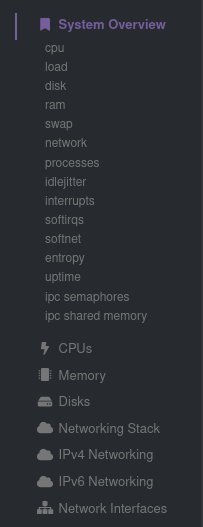 @@ -78,10 +91,10 @@ submenus](https://user-images.githubusercontent.com/1153921/80834697-11577e00-8b ### Cloud menus (Spaces, War Rooms, and Visited nodes) -The dashboard also features a menu related to Cloud functionality. You can view your existing Spaces or create new ones -via the vertical column of boxes. This menu also displays the name of your current Space, shows a list of any War Rooms -you've added you your Space, and lists your Visited nodes. If you click on a War Room's name, the dashboard redirects -you to the Netdata Cloud web interface. +The dashboard also features a menu related to Netdata Cloud functionality. You can view your existing Spaces or create +new ones via the left vertical column of boxes. This menu also displays the name of your current Space, shows a list of +any War Rooms you've added you your Space, and lists any notes you recently visited via their Agent dashboards. Click on +a War Room's name to jump to the Netdata Cloud web interface. 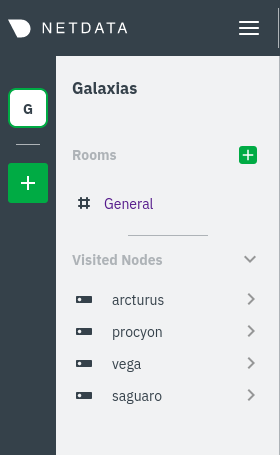 @@ -89,7 +102,7 @@ menus](https://user-images.githubusercontent.com/1153921/80837210-3f8b8c80-8bab- If you want to know more about how Cloud populates this menu, and the Agent-Cloud integration at a high level, see our document on [using the Agent with Netdata Cloud](/docs/agent-cloud.md). -## Customizing the standard dashboard +## Customizing the local dashboard Netdata stores information about individual charts in the `dashboard_info.js` file. This file includes section and subsection headings, descriptions, colors, |
